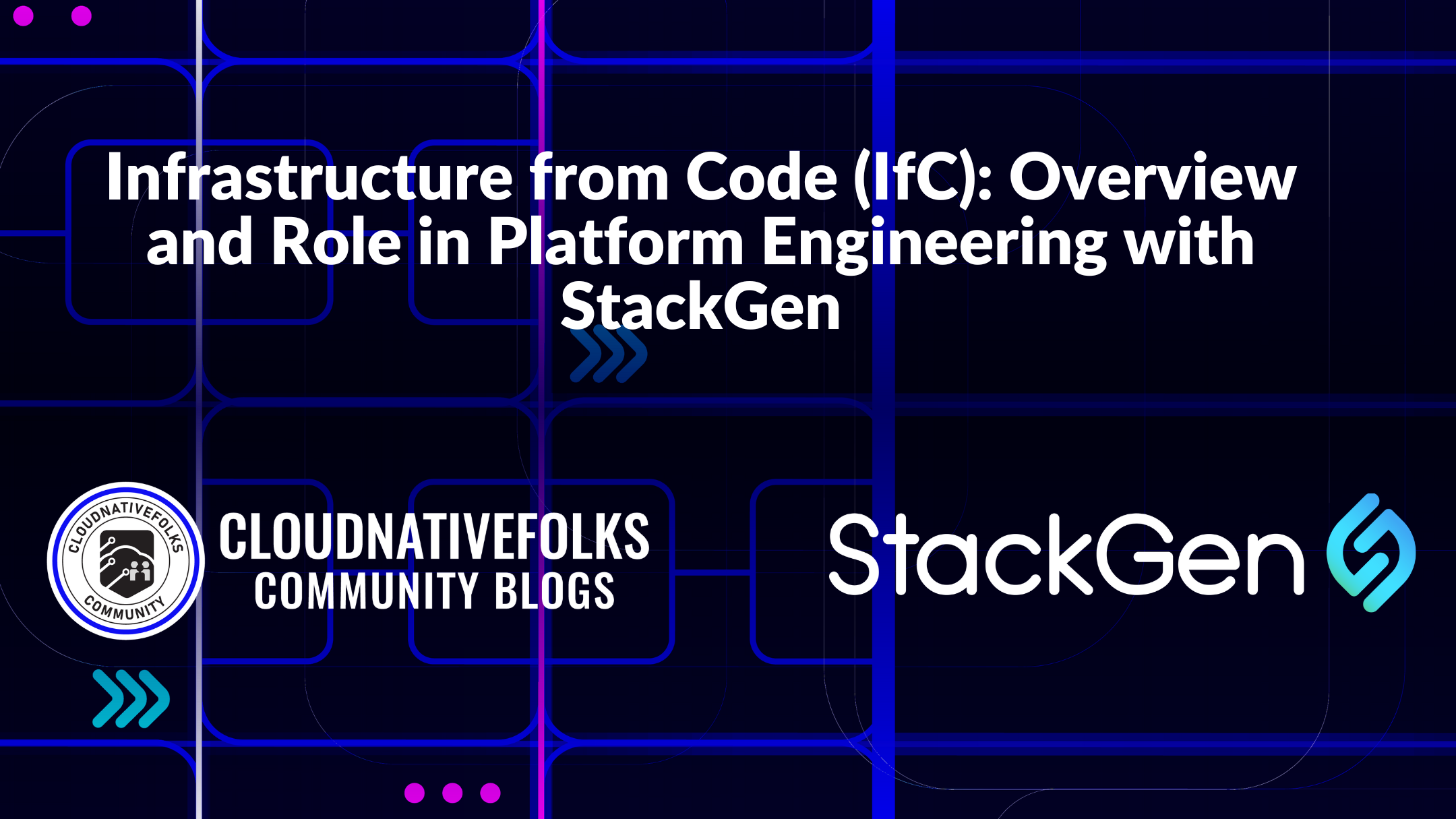Infrastructure from Code (IfC): Overview and Role in Platform Engineering with StackGen
 Sangam Biradar
Sangam Biradar
In our previous blog, we explored the concept of Infrastructure from Code (IfC) and how it automates the generation of infrastructure directly from application code. This approach eliminates the need for manually writing infrastructure as code (IaC) and ensures that best practices are applied automatically. But how can platform engineers adopt this game-changing practice? Are there tools that can make this transition easier?
In this blog, we’ll dive into the tools available to help you adopt IfC, focusing on how they can simplify your workflows, save time, and enhance infrastructure security and scalability. We'll also highlight the practical benefits of using these tools to accelerate your platform engineering processes.
Introduction to Infrastructure from Code (IfC)
Infrastructure from Code (IfC) is a transformative approach to automating infrastructure provisioning by generating infrastructure configurations directly from application code. This reduces the need for manual infrastructure management and ensures consistency across different environments. In platform engineering, IfC enables teams to build and scale platforms quickly and efficiently.
StackGen plays a crucial role in this process, simplifying infrastructure generation by automatically creating Infrastructure as Code (IaC) and applying best practice cloud policies. Even for those with limited IaC knowledge, StackGen makes it easy to review, enhance, and provide infrastructure to DevOps teams without writing any IaC from scratch.
How StackGen Saves Time for Platform Engineers
When platform engineers manage infrastructure manually, they often face several time-consuming tasks:
Writing and Maintaining IaC: Manually writing IaC for services like Terraform, Helm, or CloudFormation requires extensive time and expertise.
Applying Cloud Best Practices: Ensuring compliance and security requires knowledge of best practices, which involves time-consuming research and validation.
Scaling Infrastructure: Manually managing infrastructure scaling in response to changing application needs requires constant monitoring and adjustment.
Collaboration with DevOps Teams: Aligning IaC with DevOps practices and ensuring smooth deployment requires careful planning and review cycles.
Security and Compliance: Ensuring infrastructure meets regulatory compliance (e.g., SOC 2, HIPAA, NIST-CSF, PCI, GDPR) and security standards can take weeks of manual effort.
Using StackGen to generate Infrastructure from Code significantly reduces the time spent on these tasks. Below is a breakdown of how much time StackGen can save platform engineers:
1. Writing and Maintaining IaC
Manual Process: Writing complex IaC from scratch for infrastructure components such as networking, load balancers, storage, and databases typically takes several days to weeks depending on the complexity of the application.
With StackGen: StackGen automatically generates IaC within minutes to hours based on your application code, eliminating the need to manually write and maintain detailed configurations.
Time Reduction: StackGen reduces time spent writing and maintaining IaC by up to 90%, turning what could be a multi-week task into just a few hours.
2. Applying Cloud Best Practices
Manual Process: Researching, implementing, and validating cloud best practices (such as security, compliance, and scaling configurations) can take several days. Engineers must ensure that the infrastructure follows the best practices for the chosen cloud provider.
With StackGen: StackGen automatically applies pre-built best practice policies for AWS, Azure, and GCP, ensuring your infrastructure is compliant and secure without the need for manual intervention.
Time Reduction: StackGen reduces this process by 80-90%, saving platform engineers several days of manual configuration and testing.
3. Scaling Infrastructure
Manual Process: Monitoring and manually adjusting infrastructure to scale with demand is a time-consuming task. Engineers may spend hours or even days each week configuring autoscaling policies and adjusting infrastructure as workloads fluctuate.
With StackGen: StackGen generates Infrastructure as Code (IaC) that defines scaling parameters upfront, ensuring that infrastructure can be easily adjusted when needed. Instead of handling scaling in real time, StackGen allows engineers to set clear, predefined scaling policies through code, reducing the complexity and effort of manual adjustments.
Time Savings: StackGen reduces the time spent on configuring and managing scaling by up to 85%, as engineers can focus on defining infrastructure via IaC rather than manually adjusting resources on the fly. This approach significantly minimizes repetitive scaling tasks while maintaining flexibility.
4. Collaboration with DevOps Teams
Manual Process: Aligning infrastructure configurations with DevOps pipelines and ensuring smooth deployment often requires several review cycles and iterations, which can delay deployment timelines by days or weeks.
With StackGen: StackGen integrates seamlessly with existing DevOps workflows, automatically generating infrastructure that is ready for deployment. Engineers can review and tweak the generated IaC before passing it to DevOps teams, streamlining the process.
5. Security and Compliance
Manual Process: Ensuring that infrastructure is compliant with security regulations such as SOC 2, HIPAA, NIST-CSF, PCI, and GDPR requires significant manual effort. Platform engineers need to stay updated with the latest security guidelines, implement controls, and validate compliance—often a 1-2 week process for each system.
With StackGen: StackGen integrates automated security best practices into the generated IaC, ensuring compliance with all relevant security standards. This feature saves engineers from manually implementing these controls, reducing errors and ensuring that infrastructure is secure by design.
Time Reduction: StackGen reduces the time spent on security and compliance by 85-90%, transforming weeks of manual work into automated, built-in processes that engineers can trust.
The Bigger Picture: Time Savings with StackGen
By automating these key areas, StackGen reduces the overall infrastructure management time by up to 70-90%. Below is a comparative example of time spent manually versus using StackGen for a typical platform engineering workflow:
| Task | Manual Time | With StackGen | Time Saved |
| Writing and Maintaining IaC | 1-2 weeks | 1-2 hours | ~90% |
| Applying Cloud Best Practices | 3-5 days | Built into generated IaC | ~85-90% |
| Scaling Infrastructure | Ongoing (hours/week) | Predefined in IaC (adjustments required when needed) | ~85% (hours/week) |
| Collaboration with DevOps Teams | 3-7 days (review cycles) | 1-2 days | ~50-70% |
| Security Integration | 1-2 weeks | Automated security best practices and compliance standards (SOC 2, HIPAA, NIST-CSF, PCI, GDPR) built into IaC | ~85-90% |
Get Started Now with StackGen - https://stackgen.com/developers
Live Use Cases of StackGen in Platform Engineering
1. Microservices Deployment on AWS
Scenario: A team building a microservices-based application on AWS.
Manual Process: Writing Terraform or CloudFormation templates for provisioning AWS resources like VPCs, load balancers, and databases could take up to 2-3 weeks.
With StackGen: The team connects their code repository to StackGen, specifies AWS as the target, and the necessary infrastructure is automatically generated in less than a day.
Time Saved: ~2-3 weeks.
2. Kubernetes-Based Platform on AWS Cloud
Scenario: A company using Kubernetes to manage containerised workloads on AWS Cloud.
Manual Process: Provisioning EKS clusters, managing networking and storage, and ensuring best practices can take several days to weeks.
With StackGen: The Kubernetes infrastructure is generated automatically within hours, complete with security and scaling best practices.
Time Saved: ~1-2 weeks.
3. Serverless Application on AWS Lambda
Scenario: A startup deploying a serverless application on AWS Lambda.
Manual Process: Configuring Lambda functions, API Gateway, and DynamoDB manually could take a few days to a week.
With StackGen: The infrastructure is generated automatically within a few hours, fully optimized for serverless workloads.
Time Saved: ~4-5 days.
Conclusion
By leveraging StackGen, platform engineers can drastically reduce the time spent on infrastructure management—by as much as 70-90%—while ensuring compliance with best practices. Whether it's deploying microservices, Kubernetes clusters, or serverless applications, StackGen automates complex processes, saving platform teams weeks of effort and enabling faster deployment cycles. This time-saving capability allows engineers to focus on innovation and scaling their platforms, rather than getting bogged down in manual IaC tasks.
Subscribe to my newsletter
Read articles from Sangam Biradar directly inside your inbox. Subscribe to the newsletter, and don't miss out.
Written by

Sangam Biradar
Sangam Biradar
DevRel at StackGen | Formerly at Deepfence ,Tenable , Accurics | AWS Community Builder also Docker Community Award Winner at Dockercon2020 | CyberSecurity Innovator of Year 2023 award by Bsides Bangalore | Docker/HashiCorp Meetup Organiser Bangalore & Co-Author of Learn Lightweight Kubernetes with k3s (2019) , Packt Publication & also run Non Profit CloudNativeFolks / CloudSecCorner Community To Empower Free Education reach out me twitterhttps://twitter.com/sangamtwts or just follow on GitHub -> https://github.com/sangam14 for Valuable Resources